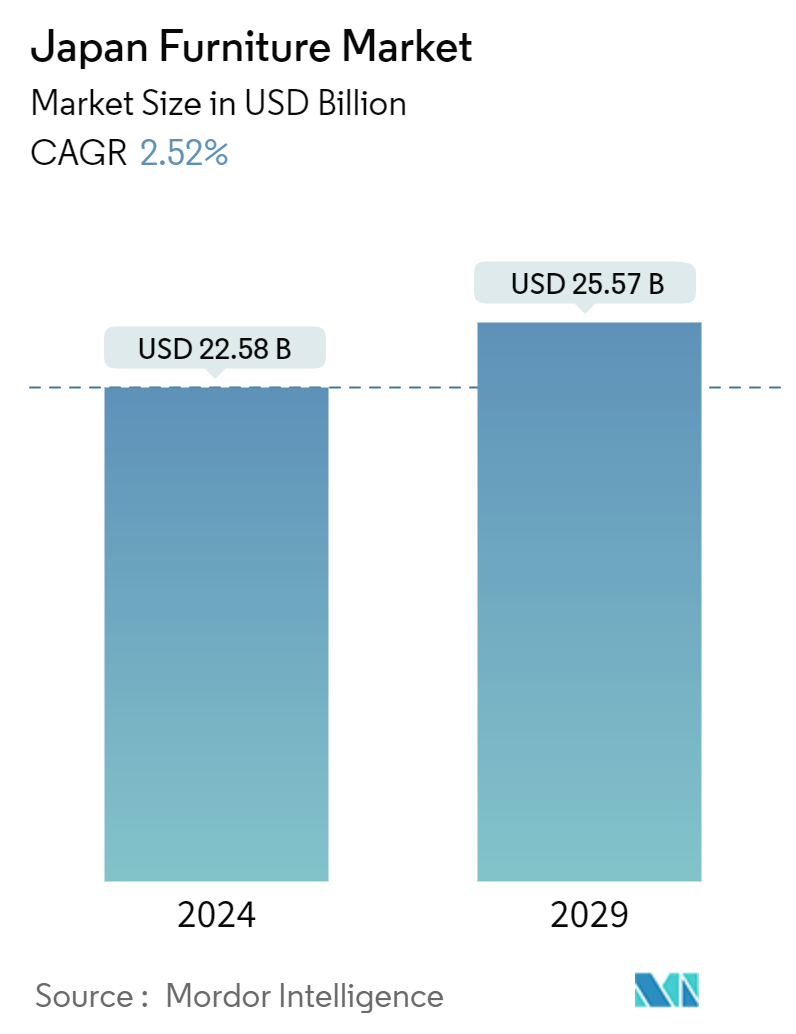Market Size of Japan Furniture Industry

| Study Period | 2020 - 2029 |
| Base Year For Estimation | 2023 |
| Market Size (2024) | USD 22.58 Billion |
| Market Size (2029) | USD 25.57 Billion |
| CAGR (2024 - 2029) | 2.52 % |
| Market Concentration | Low |
Major Players
*Disclaimer: Major Players sorted in no particular order |
Japan Furniture Market Analysis
The Japan Furniture Market size is estimated at USD 22.58 billion in 2024, and is expected to reach USD 25.57 billion by 2029, growing at a CAGR of 2.52% during the forecast period (2024-2029).
The outbreak of the COVID-19 pandemic acted as a massive restraint on the furniture market in 2020 as supply chains were disrupted due to trade restrictions and consumption declined due to lockdowns imposed by governments globally. Steps by national governments to contain the transmission of the virus resulted in the halting of manufacturing activities and a decline in economic activity, with countries entering a state of "lockdown." However, the furniture market is now recovering and is expected to grow at a strong rate.
Some of the major factors driving the demand for furniture products in the country include rising disposable income, increasing household and commercial spaces, and rising urbanization. The Japanese furniture industry had evolved from a small market of around 50 billion yen to nearly 3.5 trillion yen in 2019. The popularity of high-end and luxury furniture is a big part of why Japanese people buy so much furniture.
The country is witnessing increased construction activity, which has led to the expansion of residential real estate and a significant increase in the number of households in the country. This is boosting the demand for furniture products such as living room and bedroom furniture. The country is also witnessing an increased demand for office furniture products due to the rising consumption of office spaces, fueling market demand. When people in Japan start a new family, there is also a rise in demand for beautiful, long-lasting high-end solid wood furniture. This helps the market grow.
The market share of imported furniture in Japan has risen significantly in the last few years. Among imported furniture, wooden furniture occupies the largest proportion, followed by furniture accessories, metal furniture, plastic furniture, etc. With low labor costs, China has become Japan's largest furniture importer, accounting for nearly 40% of the total Japanese wooden furniture imports. Some of the other countries that import furniture products from Japan are Thailand, Vietnam, Malaysia, the Philippines, Indonesia, Germany, and Italy.
Japan Furniture Industry Segmentation
The furniture market consists of various movable pieces of furniture such as chairs, desks, beds, cabinets, etc. They are used for various human activities like sleeping, sitting, and storage.
The Japanese furniture market is segmented by material, application, and distribution channel. The market by material is further segmented into wood, metal, plastic, and other furniture. The market by application is further segmented into home furniture, office furniture, hospitality furniture, and other furniture. The market by distribution channel is further segmented into supermarkets, hypermarkets, specialty stores, online, and other distribution channels. The market size and forecasts are provided in terms of value (USD) for all the above segments.
| By Material | |
| Wood | |
| Metal |
| By Application | |
| Home Furniture | |
| Office Furniture | |
| Hospitality Furniture |
| By Distribution Channel | |
| Supermarkets & Hypermarkets | |
| Specialty Stores | |
| Online | |
| Others |
| COMPETITIVE LANDSCAPE | ||||||||||||
| Market Competion Overview | ||||||||||||
|
Japan Furniture Market Size Summary
The Japanese furniture market is poised for steady growth, driven by factors such as rising disposable incomes, increasing urbanization, and the expansion of residential and commercial spaces. The market, which faced significant challenges during the COVID-19 pandemic due to supply chain disruptions and decreased consumer spending, is now on a recovery path. The demand for furniture is being bolstered by increased construction activities and a growing number of households, which in turn is fueling the need for various types of furniture, including living room, bedroom, and office furniture. The trend towards high-end and luxury furniture is also notable, as consumers seek durable and aesthetically pleasing options, particularly solid wood furniture, which is favored for its longevity and quality.
The market landscape is characterized by a mix of local and international players, with companies like Nitori, Muji, and IKEA offering a diverse range of styles and designs to cater to different consumer preferences. The rise in single-person households is influencing furniture demand, as these households require space-efficient and multifunctional furniture solutions. This demographic shift is creating opportunities for competitively priced items that maximize utility in smaller living spaces. Additionally, the import of wooden furniture from countries like China and Vietnam highlights the global interconnectedness of the market. The ongoing expansion of retail outlets, such as IKEA's new store in the North Kanto region, underscores the dynamic nature of the Japanese furniture market, which continues to evolve in response to changing consumer needs and preferences.
Japan Furniture Market Size - Table of Contents
-
1. MARKET INSIGHTS AND DYNAMICS
-
1.1 Market Overview
-
1.2 Market Drivers
-
1.3 Market Restraints
-
1.4 Market Opportunities
-
1.5 Value Chain/Supply Chain Analysis
-
1.6 Industry Attractiveness - Porter's Five Forces Analysis
-
1.6.1 Bargaining Power of Buyers
-
1.6.2 Bargaining Power of Suppliers
-
1.6.3 Threat of New Entrants
-
1.6.4 Threat of Substitutes
-
1.6.5 Intensity of Competitive Rivalry
-
-
1.7 Insights of Technology Innovations in the Market
-
1.8 Impact of COVID-19 on the Market
-
-
2. MARKET SEGMENTATION
-
2.1 By Material
-
2.1.1 Wood
-
2.1.2 Metal
-
-
2.2 By Application
-
2.2.1 Home Furniture
-
2.2.2 Office Furniture
-
2.2.3 Hospitality Furniture
-
-
2.3 By Distribution Channel
-
2.3.1 Supermarkets & Hypermarkets
-
2.3.2 Specialty Stores
-
2.3.3 Online
-
2.3.4 Others
-
-
2.4 COMPETITIVE LANDSCAPE
-
2.4.1 Market Competion Overview
-
2.4.2 Company Profiles
-
2.4.2.1 Nitori
-
2.4.2.2 Muji
-
2.4.2.3 Karimoku Furniture Co., Ltd.
-
2.4.2.4 IKEA Kobe
-
2.4.2.5 Cassina Ixc
-
2.4.2.6 Huasheng Furniture Group
-
2.4.2.7 Ariake
-
2.4.2.8 CondeHouse
-
2.4.2.9 Hida Sangyo
-
2.4.2.10 Miyazaki Chair Factory
-
- *List Not Exhaustive
-
-
Japan Furniture Market Size FAQs
How big is the Japan Furniture Market?
The Japan Furniture Market size is expected to reach USD 22.58 billion in 2024 and grow at a CAGR of 2.52% to reach USD 25.57 billion by 2029.
What is the current Japan Furniture Market size?
In 2024, the Japan Furniture Market size is expected to reach USD 22.58 billion.

